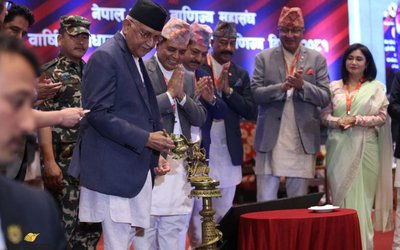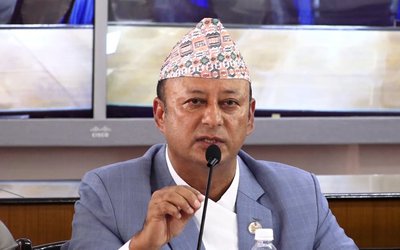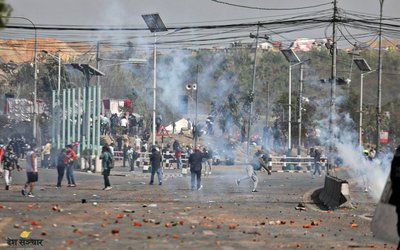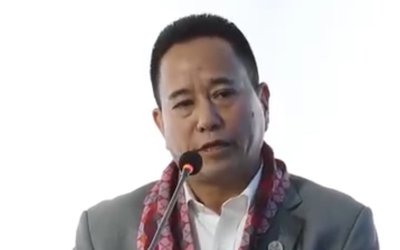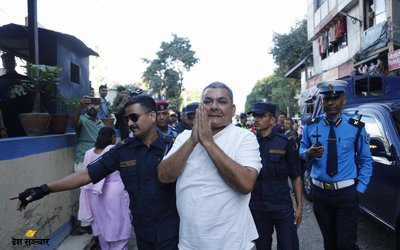
Finance Minister Barsaman Pun and three vice presidents of the World Bank have discussed major infrastructure projects in Nepal.
During a virtual meeting on Friday, they discussed creating a partnership blueprint between Nepal and the Bank for the next five years and advancing the Upper Arun Hydroelectric Project and the Dudhkoshi Reservoir Project, according to the Ministry of Finance.World Bank Vice Presidents Martin Raiser, Akihiko Nishio and Guangzhe Chen and Asian Development Bank Country Director for Nepal Arnaud Cauchois and International Finance Corporation (IFC) representatives par-ticipated in the meeting.Similarly, on behalf of Nepal, Min-ister Pun as well as Finance Secretary Dr. Krishna Hari Puskar, Revenue Secretary Dr. Ram Prasad Ghimire, Joint Secretaries Uttar Kumar Khatri and Ritesh Kumar Shakya and Shree Krishna Nepal and Managing Director of Nepal Electricity Authority Kul Man Ghising participated.
When Finance Minister Pun was the Minister of Energy, Water Resources and Irrigation earlier, the construction process of the 1,061 MW Upper Arun Hydropower Project to be built in Bhot-khola Rural Municipality of Sankhu-wasabha as a ‘game changer’ project had advanced.The Upper Arun project is consid-ered an attractive project as it produces more electricity even in winter.It has been decided to construct the project through a subsidiary com-pany of the Nepal Electricity Author-ity with the mixed investment of the World Bank’s concessional loan and Citizen Investment Trust, various domestic banks and financial institu-tions. Plans are also there to provide shares for the general people.To advance the project, the NEA has established Upper Arun Hydropower Limited.
The detailed project report (DPR) has already been prepared, the consul-tant has already been selected, and the financial management under the lead-ership of the World Bank is ready to be decided by mid-July 2024.The design of the project has been prepared to operate at full capacity for 6 hours a day in winter. The estimated cost of the project is USD 1.38 billion (about Rs. 161 billion).Out of the total cost, 70 per cent for-eign investment and 30 per cent domes-tic investment have been arranged.
The project will generate about 4.53 billion units of energy annually.Similarly, there is a plan to build a reservoir on the Dudhkoshi River and generate 635 megawatts of hydro-power at Lamidanda of Rawabesi Rural Municipality-3 in Khotang and Rabhu-nwaghat of Chishankhugadhi Rural Municipality-6 in Okhaldhunga.Under the leadership of the Asian Development Bank, the project is going to be constructed with the investment of the World Bank, Citizen Investment Trust and the general public.In the meeting, Minister Pun thanked the World Bank for its contribution to Nepal’s economic development as one of the major international development partners.Informing about the progress of development projects with the invest-ment of the World Bank in the areas of transport, urban development, agriculture, forestry, environment and employment, he said that the progress of those projects was not satisfactory due to various reasons.
However, he said that he was com-mitted to accelerating the work of the projects.Discussing that many significant programmes have been completed in Nepal under the International Devel-opment Association (IDA), he said that Nepal has adopted the recognition of green inclusive development.He urged the World Bank to increase green finance in infrastructure projects.Due to financial limitations caused by the laxity in revenue mobilisation, there has been a huge gap in resources in the implementation of sustainable development goals, infrastructure, cli-mate adaptation, said Minister Pun, adding that development partners, including the World Bank should help Nepal in its economic revival efforts by increasing cooperation with Nepal.In the meeting, officials including the vice presidents of the World Bank said that the cooperation with Nepal was very encouraging and expressed their opinion about the projects in the pipe-line, including the Upper Arun Hydro-power Project.Stating that Nepal’s debt risk is low compared to other countries where IDA programmes have been conducted, they urged Nepal to use non-conces-sional loans as well.
- Trump Announces 90-day Pause In Reciprocal Tariffs, Except For China
- Apr 10, 2025
- Health Minister Paudel Addresses 58th session of UN Health Commission
- Apr 09, 2025
- China, EU Vow To Cooperate In Safeguarding Free Trade
- Apr 09, 2025
- Trump tariffs loom, reach 104% on China
- Apr 09, 2025
- Trump and Netanyahu talk trade, Gaza and Iran
- Apr 08, 2025


